General
Ken Anderson and the Haunted Mansion — Part I
JimHillMedia.com proudly introduces its newest columnist: Disney historian Wade Sampson. Wade makes a pretty spectacular debut at the site today by presenting the first installment of his two part series on Disney Legend Ken Anderson’s contributions to Disneyland’s “Haunted Mansion.”

Hey, gang!
Jim Hill here. You know, a month and a half ago, we were wondering how we were ever going to replace that that Disney-history-lovin’, comic-book-collectin’ writing machine known as Jim Korkis. His unexpected departure back in September left a large void at JHM (not to mention a huge hole in our hearts).
Of course, who could have known that — just five weeks later — we’d have had so many great new writers suddenly come on board at JimHillMedia.com. Truly talented folks like Jackson “Pop Culture” King, Jean de Lutèce, Larry Pontius, Monique Pryor and Matthew Springer. Who — while they can never really replace the amazing Mr. Korkis — do have some really great stories of their own to tell.
Well, today, I’m pleased to announce that we’re adding another writer to the roster: Disney historian Wade Sampson. Who — not-so-co-incidentally — happens to be an old friend of Jim K. who — when he heard that Mr. Korkis was leaving JHM — volunteered to take over the Disney history side of the site.
Well — given that I actually know a few stories about the Mouse House — I wasn’t entirely sure that JimHillMedia.com needed another Disney historian. But Jim K. (Who says “Hello,” by the way) put in a good word for the guy. And then Wade delivered this absolutely killer two part story about Ken Anderson’s conceptual contributions to Disneyland’s “Haunted Mansion.”
After reading both parts of this article, all reservations that I may have had about Mr. Sampson immediately evaporated. Which is why I’m pleased now to introduce to you Wade Sampson. Who — while he’s no Jim Korkis — can still spin a pretty mean yarn about the Mouse.
Part I of Sampson’s seasonal appropriate tale will run today. Part II — which will actually go into great detail about what Anderson originally wanted to do with Disneyland’s “Haunted Mansion” — will run on Thursday.
Okay. Enough with the prolonged introductory comments. Ladies and gentlemen, please welcome Wade Sampson!
There are times when I wish I was in Florida and a cast member at Walt Disney World (and just as many times when I am grateful not to be) because in November there are several learning activities offered to those who work there including early morning behind the scenes tours of the Haunted Mansion with the lights on, a presentation on the various Haunted Mansions around the world and an intriguing presentation by Disney Historian Jim Korkis on “The Haunted Mansion That Never Was” which will explore some of the early concepts of the famous Disney attraction. (In fact on Halloween, Jim will be presenting to cast members his famous “Mickey Meets the Monsters” presentation about the horror influences in the early black and white Mickey Mouse cartoons.)
Many, many years ago, I attended a Mouse Club event where Jim was eloquently and passionately trying to convince some Disneyphiles that while Marc Davis and Yale Gracey and X. Atencio were well deserving of the attention they were getting for their contributions to the Haunted Mansion that the “forgotten” man in the story of the Haunted Mansion was Ken Anderson whose early work on the project strongly influenced some of the things we love best about that attraction.
Over my years of research, I have come to agree with that viewpoint and thought that the readers of this website might enjoy during this Halloween season a look at one of Ken’s early concepts of the Haunted Mansion in particular.
And I strongly recommend to those interested in how Disney projects develop to purchase a copy of the recent book THE HAUNTED MANSION: FROM THE MAGIC KINGDOM TO THE MOVIES by Jason Surrell which is available at www.amazon.com . Jason did an outstanding job despite the fact that Disney Press severely limited his page count just as they did with John Canemaker on his recent book about Mary Blair. Both Jason and John had many more great stories to share. I was happy to see Jason devoting some pages to Ken Anderson’s contributions.
Ken Anderson (1909-1993) had a Bachelor of Architecture degree and fully intended to pursue a career as an architect but kept getting sidetracked. He was employed at MGM Studios as a sketch artist (working on films like THE PAINTED VEIL and WHAT EVERY WOMAN KNOWS). One day driving by the Disney Hyperion Studio in early 1934, he went in and applied on a whim even though he told his wife Polly that he didn’t know how to draw cartoons.
Impressed with his portfolio, the Disney Studio hired him and Ken began his Disney career in 1934 contributing to many animated classics as art director beginning with SNOW WHITE AND THE SEVEN DWARFS. Since he had an architectural background, he came up with innovative perspective on such Silly Symphony cartoons as GODDESS OF SPRING and THREE ORPHAN KITTENS.
Disney Historian Paul Anderson once wrote that, “At Disney, he showed a versatility that has long since gone unmatched. He did so many different things for Disney, that it prompted Walt once to call him ‘my jack-of-all-trades’.”
In fact, Ken’s official credits list such titles at Disney as art direction, art supervision, story, color, styling, layout, production, character development and more.
He worked on the classic scene of the dwarfs dancing with Snow White but it became apparent that his talents lay not in animation but in such areas as production design on such films as SLEEPING BEAUTY and 101 DALMATIANS. Ken, in fact, was the one who okayed the use of xeroxgraphy in the later film which led to a temporary rift with Walt Disney as well as Ken’s first heart attack when he felt he had failed Walt.
Specializing in character design in later years, he designed such characters as Shere Khan in THE JUNGLE BOOK and Elliott the Dragon in PETE’S DRAGON. “I don’t know how I came up with Elliott,” Ken told the late Steve Fiott, “I like to think of him as an example of China’s concept of the dragon as a symbol of luck and good will which come to them when they need him. He just came to me, and I sure needed him!”
It is Ken’s innovative character design on the animated feature ROBIN HOOD (which basically was an animal head placed on a human body covered with fur) that inspired an entire generation of young artists including a group of character costume builders known as “furries”.
Ken also designed many parts of Disneyland, including major portions of Fantasyland like the early dark rides of SNOW WHITE and MR. TOAD as well as designing the Storybook Land Canal Boat experience and others. He retired on March 31, 1978 but continued to consult at WED Enterprises. He was honored with the Disney Legends award in 1991. One of the last contributions Ken made to Disney was on CATFISH BEND, a proposed animated feature for which Ken made some preliminary sketches.
Ken was eighty-four years old when he passed away. Forty-four of those years had been spent in the service of the Disney company.
While it had always been part of Walt Disney’s vision for Disneyland to include an old haunted house, he had originally considered having it located on a side street off of Main Street. By 1957, when Walt gave an interview to the BBC about his plans of a retirement home for ghosts, Walt envisioned it being located in an area of Frontierland that had a New Orleans theme. It was at this time that Ken had just moved over to WED (Imagineering) from the Disney Studio and Walt turned to his “jack of all trades” to research some possibilities.
As Paul Anderson told me, “We always hear about ‘the group of Imagineers’ that went out to research the Haunted Mansion. Actually, ‘the group’ was just Ken.”
While Ken Anderson’s initial sketch of a decaying mansion was apparently loosely based on the Evergreen House in Baltimore, Maryland and that is the sketch that Sam McKim transformed into the famous concept painting, it is also apparent that Ken’s approach to a Disney “walk through” Haunted House was greatly influenced by his experiences at the Winchester Mystery House in San Jose.
Sometimes called the “ghost mansion”, this popular tourist attraction has doors and staircases that lead nowhere and a maze of rooms that were constantly being redone by the widow of the maker of the Winchester rifle. She was under the belief that the ghostly victims of the Winchester rifle had cursed her family and were haunting her to keep building more and more rooms for their earthbound spirits. It was even rumored that through “automatic writing”, she received building directions which she passed along to the carpenters.
Ken Anderson had two pages of notes on the Winchester House from the size of the tour group (maximum of 20), the mix of adults and children (roughly four times the number of adults to children), the maximum/minimum entrance and exit time in each area (25 seconds to 60 seconds), the maximum/minimum time the guide spoke in each area (32 seconds to three and a half minutes), as well as a variety of notes like “average group well behaved” and “rooms are all empty-nothing to touch”.
Ken strongly believed that a cohesive story was necessary to guide Disney guests through the Haunted Mansion. Not only was storytelling an important element of the Disney Brand and had positioned Disney’s “dark rides” as different from carnival amusement park dark rides but storytelling would be necessary to move guests through the experience rather than have them dawdle in one area and clog up the flow of traffic. In 1957, Ken literally developed four story concepts, all of which feature elements reflected in the final version of the attraction that was eventually opened at Disneyland.
Perhaps the best known version was Ken’s first attempt which featured the Legend of Captain Gore and was written in February of 1957. The mansion was the seaside manor of an old sea captain who had married a young woman named Priscilla. She discovers he is actually a notorious pirate. Gore killed his bride (and in one version tossed her bloody body into an outside well that still bubbles red) and she haunted him until he took his own life by hanging himself. This story would have been shared with guests by a butler or maid who worked in the mansion.
Another version was Bloodmere Manor, which was the lakeside estate of “the unfortunate Blood family. It was built about 1800 in the swampy bayous near New Orleans and was moved here (Disneyland) intact because it was an example of early architecture from that section of our country. It had not been occupied for some time and was badly in need of repair, so we started the work of restoration as soon as it arrived at Disneyland, but strangely enough…the work of each day was destroyed during the night…and the night watchman reported that when he had passed the house he’d heard eerie screams and seen weird lights… In fact, we are sorry to report that the latest tragedy of all occurred here in Disneyland…when one of our carpenters engaged in restoration work on the house disappeared completely from sight…and he has not been seen or heard from since. The house is now too dangerous to live in, but we have succeeded in making it safe enough for a visit…when accompanied by our trained and competent guide, a former butler of the household.”
A third version had Walt himself as the narrator on tape as the guests wandered through the house to go to a ghostly wedding celebration. Still another version focused on the Headless Horseman from the Disney animated film about Ichabod Crane on Halloween night. This version also featured another wedding. This one was between Monsieur Bogeyman and Mlle. Vampire. The bride jilts the groom at the altar, sparking chaos and the need to quickly exit the mansion.
Let’s take a closer look at Ken Anderson second revision of the “Bloodmere Manor” version of the Haunted Mansion which is dated September 17, 1957.
This twenty-four page, double spaced document is amazingly detailed as evidenced by this description from the first page:
“Guests will be admitted to the grounds through a large wrought iron pedestrian and vehicle gate typical of New Orleans, Circa 1800. The ticket booth (REMEMBER THIS IS 1957 WHERE EACH ATTRACTION REQUIRED A TICKET) will be located in the brick and plaster gatehouse which terminates the wrought iron fence. Posted conspicuously on the gatehouse are copies of the Times Picayune and Leslie’s Magazine, with headlines about atrocities connected with the ghost house in the past. The approach to the house will be along paths lined with Azaleas and moss-festooned magnolias and southern oak trees. The garden shows evidence of a once well-planned symmetry and beauty, but is now overgrown and obviously out of control.”
“Vines and moss combined in the tall trees shut out much of the sunlight, and lend mystery to the shadowy exterior of the house. Being set well back from the street behind the grove of trees, the house will be scarcely visible until close upon it. It appears to be in a state of dilapidation common to all ghost houses. First at one upstairs window and then another, a girl’s face appears momentarily, screams and is throttled by a large hairy hand which draws her back into the darkness.”
Notations on this revision also indicate that Ken had utilized his experience at the Winchester House in terms of audience flow. Ken estimated that a group of no more than forty guests would gather on the front porch to enter the house. He figured that at regularly spaced intervals of one and half minutes that roughly eight groups of forty guests each (320 guests total) could be in the house simultaneously or a possible 16,000 visitors in a ten hour schedule.
“If the show in each room lasts a minute, it would leave fifteen seconds to enter the room, and fifteen seconds to clear the room. We are conducting tests with groups of forty people, using the ZORRO sets, to determine the practicality of this timing. In room clearance tests so far, times ranged from fifteen seconds to twenty-five seconds for an average of twenty seconds. As soon as construction of the test mock-ups for optical illusions are completed, we will utilize them for further crowd capacity tests; which will include a one minute show of the illusions. A tour of the house should take an average of about twelve minutes to complete,” wrote Ken.
So did you realize that on the Disney Studios backlot, the Zorro sets served as the first Haunted Mansion experience? The first episode of Disney’s ZORRO appeared on ABC in October 1957 but workers had started building the sets in June 1955 and they were the Disney Studios’ first permanent sets costing over $100,000. Do you recall the so-called Disney urban legend that one of the things causing the delays of the opening of the Haunted Mansion was that it was too scary for test audiences but other scholars aptly pointing out that the Mansion at Disneyland was just a hollow shell so test audiences couldn’t have experienced the Mansion? Well, apparently there were test audiences going through the experience as early as 1957 on the backlot of the Disney Studios. I wonder if something unfortunate happened then which resulted in the birth of that Disney urban legend?
General
Seward Johnson bronzes add a surreal, artistic touch to NYC’s Garment District

Greetings from NYC. Nancy and I drove down from New
Hampshire yesterday because we'll be checking out
Disney Consumer Products' annual Holiday Showcase later today.
Anyway … After checking into our hotel (i.e., The Paul.
Which is located down in NYC's NoMad district), we decided to grab some dinner.
Which is how we wound up at the Melt Shop.

Photo by Jim Hill
Which is this restaurant that only sells grilled cheese sandwiches.
This comfort food was delicious, but kind of on the heavy side.

Photo by Jim Hill
Which is why — given that it was a beautiful summer night
— we'd then try and walk off our meals. We started our stroll down by the Empire
State Building
…
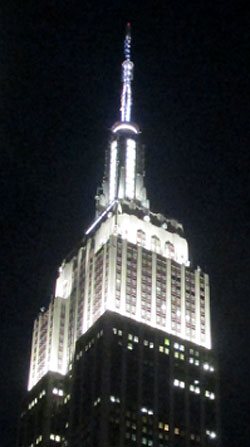
Photo by Jim Hill
… and eventually wound up just below Times
Square (right behind where the Waterford Crystal Times Square New
Year's Eve Ball is kept).

Photo by Jim Hill
But you know what we discovered en route? Right in the heart
of Manhattan's Garment District
along Broadway between 36th and 41st? This incredibly cool series of life-like
and life-sized sculptures that Seward
Johnson has created.

Photo by Jim Hill
And — yes — that is Abraham Lincoln (who seems to have
slipped out of WDW's Hall of Presidents when no one was looking and is now
leading tourists around Times Square). These 18 painted
bronze pieces (which were just installed late this past Sunday night / early
Monday morning) range from the surreal to the all-too-real.
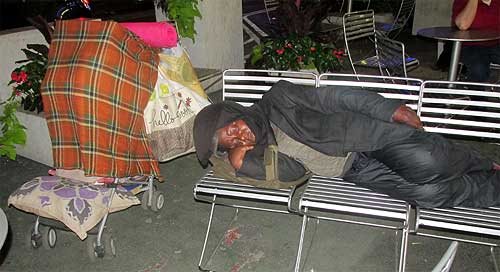
Photo by Jim Hill
Some of these pieces look like typical New Yorkers. Like the
business woman planning out her day …

Photo by Jim Hill
… the postman delivering the mail …

Photo by Jim Hill
… the hot dog vendor working at his cart …

Photo by Jim Hill
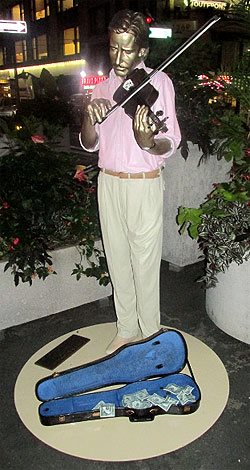
Photo by Jim Hill
… the street musician playing for tourists …

Photo by Jim Hill
Not to mention the tourists themselves.
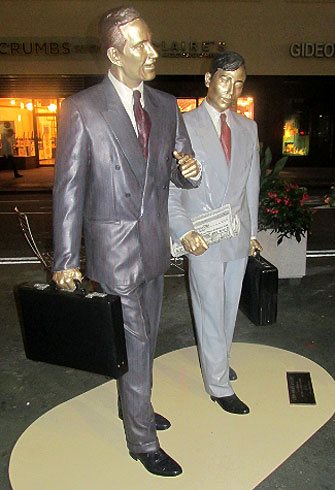
Photo by Jim Hill
But right alongside the bronze businessmen …

Photo by Jim Hill
… and the tired grandmother hauling her groceries home …
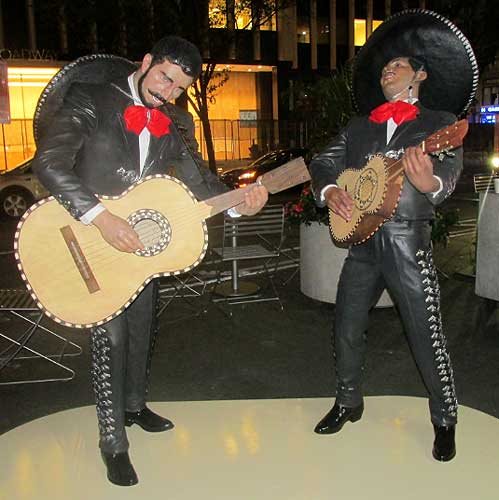
Photo by Jim Hill
… there were also statues representing people who were
from out-of-town …

Photo by Jim Hill
… or — for that matter — out-of-time.

Photo by Jim Hill
These were the Seward Johnson pieces that genuinely beguiled. Famous impressionist paintings brought to life in three dimensions.

Note the out-of-period water bottle that some tourist left
behind. Photo by Jim Hill
Some of them so lifelike that you actually had to pause for
a moment (especially as day gave way to night in the city) and say to yourself
"Is that one of the bronzes? Or just someone pretending to be one of these
bronzes?"
Mind you, for those of you who aren't big fans of the
impressionists …

Photo by Jim Hill
… there's also an array of American icons. Among them
Marilyn Monroe …
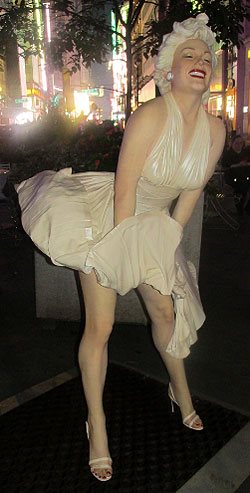
Photo by Jim Hill
… and that farmer couple from Grant Wood's "American
Gothic."

Photo by Jim Hill
But for those of you who know your NYC history, it's hard to
beat that piece which recreates Alfred Eisenstaedt's famous photograph of V-J Day in Times Square.

Photo by Jim Hill
By the way, a 25-foot-tall version of this particular Seward
Johnson piece ( which — FYI — is entitled "Embracing Peace") will actually
be placed in Times Square for a few days on or around August 14th to commemorate the 70th
anniversary of Victory Over Japan Day (V-J Day).

Photo by Jim Hill
By the way, if you'd like to check these Seward Johnson bronzes in
person (which — it should be noted — are part of the part of the Garment
District Alliance's new public art offering) — you'd best schedule a trip to
the City sometime over the next three months. For these pieces will only be on
display now through September 15th.
General
Wondering what you should “Boldly Go” see at the movies next year? The 2015 Licensing Expo offers you some clues

Greeting from the 2015 Licensing Expo, which is being held
at the Mandalay Bay
Convention Center in Las
Vegas.

Photo by Jim Hill
I have to admit that I enjoy covering the Licensing Expo.
Mostly becomes it allows bloggers & entertainment writers like myself to
get a peek over the horizon. Scope out some of the major motion pictures &
TV shows that today's vertically integrated entertainment conglomerates
(Remember when these companies used to be called movie studios?) will be
sending our way over the next two years or so.
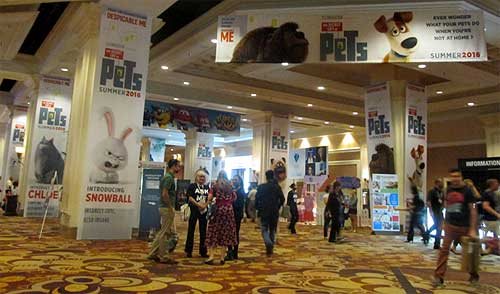
Photo by Jim Hill
Take — for example — all of "The Secret Life of
Pets" banners that greeted Expo attendees as they made their way to the
show floor today. I actually got to see some footage from this new Illumination
Entertainment production (which will hit theaters on July 8, 2016) the last time I was in Vegas. Which
was for CinemaCon back in April. And the five or so minutes of film that I viewed
suggested that "The Secret Life of Pets" will be a really funny
animated feature.

Photo by Jim Hill
Mind you, Universal Pictures wanted to make sure that Expo
attendees remembered that there was another Illumination Entertainment production
coming-to-a-theater-near-them before "The Secret Life of Pets" (And
that's "Minions," the "Despicable Me" prequel. Which
premieres at the Annecy International Animated Film Festival next week but
won't be screened stateside 'til July 10th of this year). Which is why they had
three minions who were made entirely out of LEGOS loitering out in the lobby.

Photo by Jim Hill
And Warner Bros. — because they wanted "Batman v
Superman: Dawn of Justice" to start trending on Twitter today — brought
the Batmobile to Las Vegas.
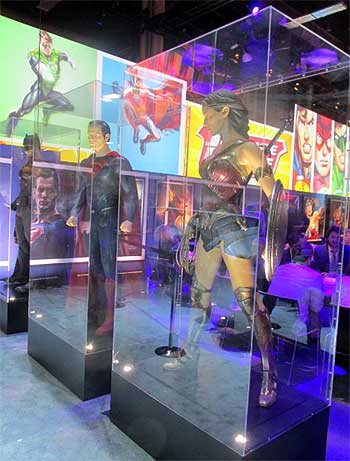
Photo by Jim Hill
Not to mention full-sized macquettes of Batman, Superman and
Wonder Woman. Just so conventioneers could then see what these DC superheroes
would actually look like in this eagerly anticipated, March 25, 2016 release.

Photo by Jim Hill
That's the thing that can sometimes be a wee bit frustrating
about the Licensing Expo. It's all about delayed gratification. You'll come
around a corner and see this 100 foot-long ad for "The Peanuts Movie"
and think "Hey, that looks great. I want to see that Blue Sky Studios production
right now." It's only then that you notice the fine print and realize that
"The Peanuts Movie" doesn't actually open in theaters 'til November
6th of this year.

Photo by Jim Hill
And fan of Blue Sky's "Ice Age" film franchise are in for an even
longer wait. Given that the latest installment in that top grossing series
doesn't arrive in theaters 'til July
15, 2016.

Photo by Jim Hill
Of course, if you're one of those people who needs immediate
gratification when it comes to your entertainment, there was stuff like that to
be found at this year's Licensing Expo. Take — for example — how the WWE
booth was actually shaped like a wrestling ring. Which — I'm guessing — meant
that if the executives of World Wrestling Entertainment, Inc. didn't like
the offer that you were making, they were then allowed to toss you out over the
top rope, Royal Rumble-style.

Photo by Jim Hill
I also have to admit that — as a longtime Star Trek fan —
it was cool to see the enormous Starship Enterprise that hung in place over the
CBS booth. Not to mention getting a glimpse of the official Star Trek 50th
Anniversary logo.
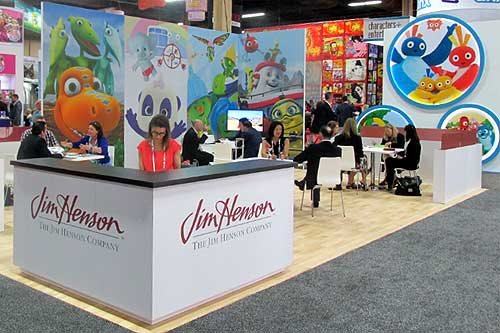
Photo by Jim Hill
I was also pleased to see lots of activity in The Jim Henson
Company booth. Which suggests that JHC has actually finally carved out a
post-Muppets identity for itself.

Photo by Jim Hill
Likewise for all of us who were getting a little concerned
about DreamWorks Animation (what with all the layoffs & write-downs &
projects that were put into turnaround or outright cancelled last year), it was
nice to see that booth bustling.

Photo by Jim Hill
Every so often, you'd come across some people who were
promoting a movie that you weren't entirely sure that you actually wanted to
see (EX: "Angry Birds," which Sony Pictures Entertainment / Columbia
Pictures will be releasing to theaters on May 20, 2016). But then you remembered that Clay Kaytis —
who's this hugely talented former Walt Disney Animation Studios animator — is
riding herd on "Angry Birds" with Fergal Reilly. And you'd think
"Well, if Clay's working on 'Angry Birds,' I'm sure this animated feature
will turn out fine."

Photo by Jim Hill
Mind you, there were reminders at this year's Licensing Expo
of great animated features that we're never going to get to see now. I still
can't believe — especially after that brilliant proof-of-concept footage
popped up online last year — that Sony execs decided not to go forward
with production of Genndy Tartakovsky's
"Popeye" movie. But that's the
cruel thing about the entertainment business, folks. It will sometime break
your heart.
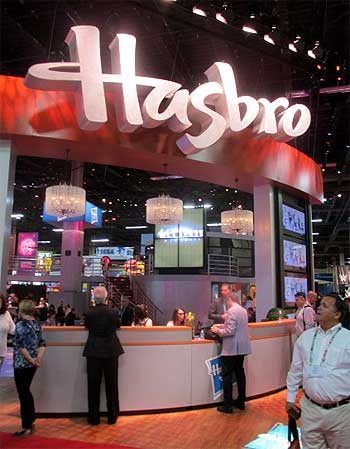
Photo by Jim Hill
And make no mistake about this. The Licensing Expo is all
about business. That point was clearly driven home at this year's show when —
as you walked through the doors of the Mandalay
Bay Convention Center
— the first thing that you saw was the Hasbros Booth. Which was this gleaming,
sleek two story-tall affair full of people who were negotiating deals &
signing contracts for all of the would-be summer blockbusters that have already
announced release dates for 2019 & beyond.

Photo by Jim Hill
"But what about The Walt Disney Company?," you
ask. "Weren't they represented on the show floor at this year's Licensing
Expo?" Not really, not. I mean, sure. There were a few companies there hyping
Disney-related products. Take — for example — the Disney Wikkeez people.
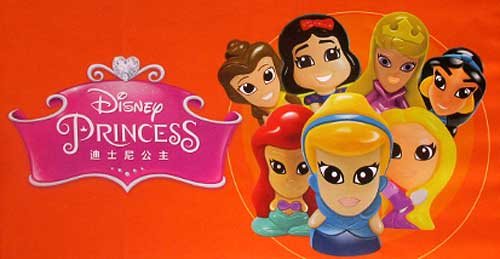
Photo by Jim Hill
I'm assuming that some Disney Consumer Products exec is
hoping that Wikkeez will eventually become the new Tsum Tsum. But to be blunt,
these little hard plastic figures don't seem to have the same huggable charm
that those stackable plush do. But I've been wrong before. So let's see what
happens with Disney Wikkeez once they start showing up on the shelves of the
Company's North American retail partners.

Photo by Jim Hill
And speaking of Disney's retail partners … They were
meeting with Mouse House executives behind closed doors one floor down from the
official show floor for this year's Licensing Expo.

Photo by Jim Hill
And the theme for this year's invitation-only Disney shindig? "Timeless
Stories" involving the Disney, Pixar, Marvel & Lucasfilm brands that
would then appeal to "tomorrow's consumer."

Photo by Jim Hill
And just to sort of hammer home the idea that Disney is no
longer the Company which cornered the market when it comes to little girls
(i.e., its Disney Princess and Disney Fairies franchises), check out this
wall-sized Star Wars-related image that DCP put up just outside of one of its
many private meeting rooms. "See?," this carefully crafted photo
screams. "It isn't just little boys who want to wield the Force. Little
girls also want to grow up and be Lords of the Sith."
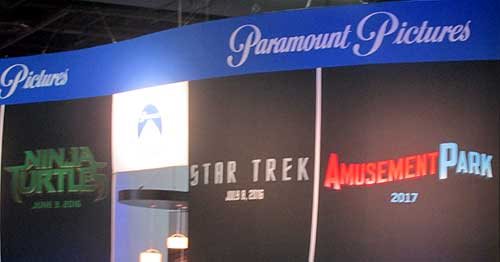
Photo by Jim Hill
One final, kind-of-ironic note: According to this banner,
Paramount Pictures will be releasing a movie called "Amusement Park"
to theaters sometime in 2017.

Photo by Jim Hill
Well, given all the "Blackfish" -related issues
that have been dogged SeaWorld Parks & Entertainment over the past two years, I'm
just hoping that they'll still be in the amusement park business come 2017.
Your thoughts?
General
It takes more than three circles to craft a Classic version of Mickey Mouse

You know what Mickey Mouse looks like, right? Little guy,
big ears?
Truth be told, Disney's corporate symbol has a lot of
different looks. If Mickey's interacting with Guests at Disneyland
Park (especially this summer, when
the Happiest Place on Earth
is celebrating its 60th anniversary), he looks & dresses like this.
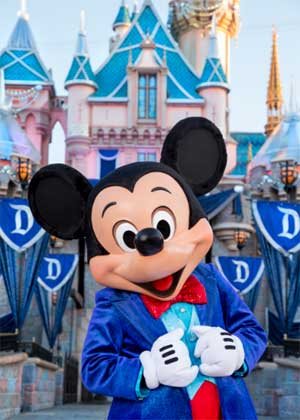
Copyright Disney Enterprises,
Inc.
All rights reserved
Or when he's appearing in one of those Emmy Award-winning shorts that Disney
Television Animation has produced (EX: "Bronco Busted," which debuts
on the Disney Channel tonight at 8 p.m. ET / PT), Mickey is drawn in a such a
way that he looks hip, cool, edgy & retro all at the same time.
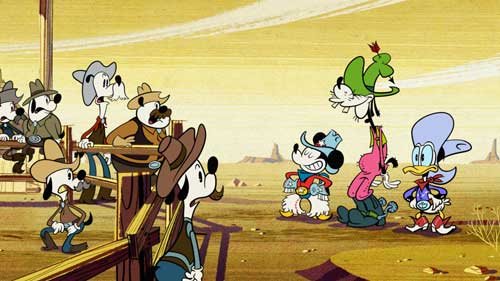
Copyright Disney Enterprises, Inc. All rights
reserved
Looking ahead to 2017 now, when Disney Junior rolls out "Mickey and the
Roadster Racers," this brand-new animated series will feature a sportier version
of Disney's corporate symbol. One that Mouse House managers hope will persuade
preschool boys to more fully embrace this now 86 year-old character.

Copyright Disney Enterprises,
Inc. All rights reserved
That's what most people don't realize about the Mouse. The
Walt Disney Company deliberately tailors Mickey's look, even his style of
movement, depending on what sort of project / production he's appearing in.
Take — for example — Disney
California Adventure
Park's "World of Color:
Celebrate!" Because Disney's main mouse would be co-hosting this new
nighttime lagoon show with ace emcee Neil Patrick Harris, Eric Goldberg really had
to step up Mickey's game. Which is why this master Disney animator created
several minutes of all-new Mouse animation which then showed that Mickey was
just as skilled a showman as Neil was.

Copyright Disney Enterprises,
Inc.
All rights reserved
Better yet, let's take a look at what the folks at Avalanche Studios just went
through as they attempted to create a Classic version of Mickey & Minnie.
One that would then allow this popular pair to become part of Disney Infinity
3.0.
"I won't lie to you. We were under a lot of pressure to
get the look of this particular version of Mickey — he's called Red Pants
Mickey around here — just right," said Jeff Bunker, the VP of Art
Development at Avalanche Studios, during a recent phone interview. "When
we brought Sorcerer Mickey into Disney Infinity 1.0 back in January of 2014,
that one was relatively easy because … Well, everyone knows what Mickey Mouse
looked like when he appeared in 'Fantasia.' "

Copyright Disney Enterprises,
Inc. All rights reserved
"But this time around, we were being asked to design
THE Mickey & Minnie," Bunker continued. "And given that these Classic
Disney characters have been around in various different forms for the better
part of the last century … Well, which look was the right look?"
Which is why Jeff and his team at Avalanche Studios began watching hours &
hours of Mickey Mouse shorts. As they tried to get a handle on which look would
work best for these characters in Disney Infinity 3.0.

Copyright Disney
Enterprises, Inc. All rights reserved
"And we went all the way back to the very start of Mickey's career. We began
with 'Steamboat Willie' and then watched all of those black & white Mickey shorts
that Walt made back in the late 1920s & early 1930s. From there, we
transitioned to his Technicolor shorts. Which is when Mickey went from being
this pie-eyed, really feisty character to more of a well-behaved leading
man," Bunker recalled. "We then finished out our Mouse marathon by
watching all of those new Mickey shorts that Paul Rudish & his team have
been creating for Disney Television Animation. Those cartoons really recapture
a lot of the spirit and wild slapstick fun that Mickey's early, black &
white shorts had."
But given that the specific assignment that Avalanche Studios had been handed
was to create the most appealing looking, likeable version of Mickey Mouse
possible … In the end, Jeff and his team wound up borrowing bits & pieces
from a lot of different versions of the world's most famous mouse. So that
Classic Mickey would then look & move in a way that best fit the sort of
gameplay which people would soon be able to experience with Disney Infinity
3.0.

Copyright Disney Enterprises,
Inc. All rights reserved
"That — in a lot of ways — was actually the toughest
part of the Classic Mickey design project. You have to remember that one of the
key creative conceits of Disney Infinity
is that all the characters which appear in this game are toys," Bunker
stated. "Okay. So they're beautifully detailed, highly stylized toy
versions of beloved Disney, Pixar, Marvel & Lucasfilm characters. But
they're still supposed to be toys. So our Classic versions of Mickey &
Minnie have the same sort of thickness & sturdiness to them that toys have.
So that they'll then be able to fit right in with all of the rest of the
characters that Avalanche Studios had previously designed for Disney Infinity."
And then there was the matter of coming up with just the
right pose for Classic Mickey & Minnie. Which — to hear Jeff tell the
story — involved input from a lot of Disney upper management.
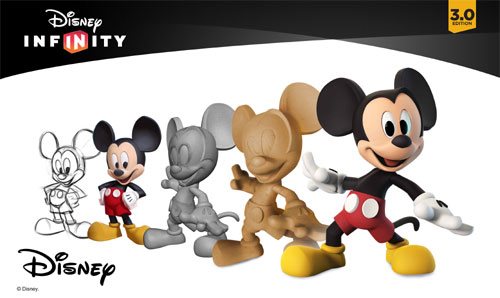
Copyright Disney Enterprises,
Inc. All rights reserved
"Everyone within the Company seemed to have an opinion
about how Mickey & Minnie should be posed. More to the point, if you Google
Mickey, you then discover that there are literally thousands of poses out there
for these two. Though — truth be told — a lot of those kind of play off the
way Mickey poses when he's being Disney's corporate symbol," Bunker said.
"But what I was most concerned about was that Mickey's pose had to work
with Minnie's pose. Because we were bringing the Classic versions of these
characters up into Disney Infinity 3.0 at the exact same time. And we wanted to
make sure — especially for those fans who like to put their Disney Infinity
figures on display — that Mickey's pose would then complement Minnie.
Which is why Jeff & the crew at Avalanche Studios
decided — when it came to Classic Mickey & Minnie's pose — that they
should go all the way back to the beginning. Which is why these two Disney icons
are sculpted in such a way that it almost seems as though you're witnessing the
very first time Mickey set eyes on Minnie.

Copyright Disney Enterprises,
Inc. All rights reserved
"And what was really great about that was — as soon as
we began showing people within the Company this pose — everyone at Disney
quickly got on board with the idea. I mean, the Classic Mickey that we sculpted
for Disney Infinity 3.0 is clearly a very playful, spunky character. But at the
same time, he's obviously got eyes for Minnie," Bunker concluded. "So
in the end, we were able to come up with Classic versions of these characters
that will work well within the creative confines of Disney Infinity 3.0 but at
the same time please those Disney fans who just collect these figures because
they like the way the Disney Infinity characters look."
So now that this particular design project is over, does
Jeff regret that Mouse House upper management was so hands-on when it came to
making sure that the Classic versions of Mickey & Minnie were specifically
tailored to fit the look & style of gameplay found in Disney Infinity 3.0?
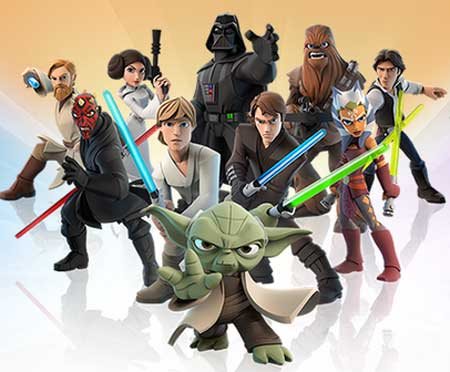
Copyright Lucasfilm / Disney
Enterprises, Inc. All rights reserved
"To be blunt, we go through this every time we add a new character to the
game. The folks at Lucasfilm were just as hands-on when we were designing the
versions of Darth Vader and Yoda that will also soon be appearing in Disney
Infinity 3.0," Bunker laughed. "So in the end, if the character's
creators AND the fans are happy, then I'm happy."
This article was originally posted on the Huffington Post's Entertainment page on Tuesday, June 9, 2015
-

 Film & Movies7 months ago
Film & Movies7 months agoBefore He Was 626: The Surprisingly Dark Origins of Disney’s Stitch
-

 History6 months ago
History6 months agoCalifornia Misadventure
-

 History10 months ago
History10 months agoThe Super Bowl & Disney: The Untold Story Behind ‘I’m Going to Disneyland!’
-

 Television & Shows11 months ago
Television & Shows11 months agoHow the Creators of South Park Tricked A-List Celebrities to Roast Universal – “Your Studio & You”
-

 Film & Movies7 months ago
Film & Movies7 months agoThe Best Disney Animation Film Never Made – “Chanticleer”
-

 Theme Parks & Themed Entertainment6 months ago
Theme Parks & Themed Entertainment6 months agoThe ExtraTERRORestrial Files
-

 History7 months ago
History7 months agoWhy Disney’s Animal Kingdom’s Beastly Kingdom Was Never Built
-

 Television & Shows8 months ago
Television & Shows8 months agoThe Untold Story of Super Soap Weekend at Disney-MGM Studios: How Daytime TV Took Over the Parks






